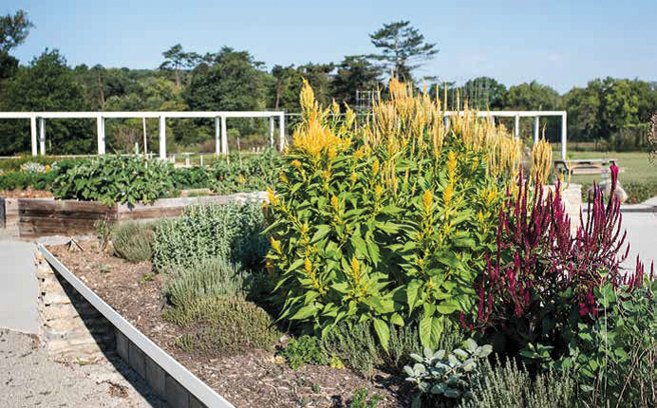Making Every Drop Count
Edible Garden
The dog days of summer 2015 overstayed their traditional August deadline, barked well into September and nearly erased the blessing of June and July’s drenching rains. But the lack of late-summer precipitation doesn’t worry the staff at Bernheim Arboretum and Research Forest in Clermont, Kentucky. The thousands of plants in its Edible Garden have stayed well hydrated during the protracted dry spell thanks to hand pumps connected to a 3,000-gallon underground cistern and an above-ground reservoir system.
Though portions of the garden were turning golden brown as of this September writing, Claude Stephens, facilitator of outreach and regenerative design at Bernheim, says the Edible Garden’s watering system is more successful than it may appear. What looks like the color of death to the untrained eye is merely the color of transition in a healthy ecosystem preparing for fall.
“Our plants are hydrated and in good shape because of the water we’ve got on hand,” Stephens says. “It’s late summer in a garden, so things are going to seed and shifting from vegetative growth to reproductive growth. It’s the end of their annual life cycle.”
Confident there’s plenty of water on hand, the staff is well into tending fall plants. Stephens says cole crops of chars and lettuces are doing well, and marigolds have burst forth to flirt with migratory butterflies he says visited in abundance this year.
Most notably, throughout the year the garden produced such a surfeit of vegetables for its onsite restaurant, Isaac’s Café, that excess produce was shared with local food banks.
All positive results, to be sure, but the Bernheim staff will tell you that it remains one step short of its vision of a truly self-sustaining garden. That will be achieved when it begins watering its plants using solar-powered pumps next year. Currently, staffers and volunteers perform the yeoman’s work of hand pumping water throughout a system of movable soaker hoses. In preparation for using the pumps, underground drilling began in September to accommodate plumbing that will steer water directly into each bed.
“Part of our thinking about all of this is to plant things that don’t require huge amounts of water anyway,” Stephens says. “What we’re doing is very intentional.”
A Watery Vision
When Bernheim opened its visitors center in 2007, it was the area’s first LEED-certified building of its kind. The staff, which designed it, admired the work for a spell before inspiration struck anew.
“It started us thinking what we could do new that further addressed ecology,” says Stephens. “We began to consider building a garden that would grow edible vegetables and that was more than sustainable.”
After some discussion, his staff settled on the ambitious goal of creating a garden with net-zero water usage, meaning its hydration would come solely from rainfall that could be stored and pumped out to the garden as needed.
The more the Bernheim staff researched the Edible Garden, the more it wanted it to meet the high standards of the Living Building Challenge, an effort funded by the National Institute of Standards and Technology to produce the most advanced sustainable design projects in the world. Groundwork on the garden began in 2012.
“The Living Building Challenge goes deeper into thinking how to design things that are like nature itself,” Stephens says. “Sustainability is often a code word for doing things less bad, and we didn’t want that. We wanted to consider things that could actually provide more energy than they require.”
Specifically, the Living Building Challenge is a certification program that defines the most advanced measures of sustainability “in the built environment.” The Challenge is comprised of seven performance categories dubbed petals: place, water, energy, health and happiness, materials, equity and beauty. Each petal is subdivided into 20 imperatives that focus on a specific sphere of influence, which in Bernheim’s case is water use in a garden.
The Bernheim team’s main goal was producing a closed-loop system for gathering rainwater, using it in the garden and returning any runoff slowly to the Bernheim forest system and nearby waterways—just as it would happen in nature.
“In such a system, we have to take responsibility for where that water comes from and where it goes,” Stephens says. “Our goal is to capture water, hold on to it, move it around our garden to grow food and then return it to a healthy ecosystem.”
The Gathering Place
The water collection cycle begins on the roof of the Bernheim research center building. Rain falling on its roof is channeled through gutters to underground pipes and cisterns. Water is then pumped to the garden or, in the case of this year’s sodden spring, the cistern’s overflow goes to an above-ground interactive teaching pond where visitors can learn about the ecology of water. From that pond the water goes to a larger pond which acts as a second reservoir for the garden. Any excess accumulating there flows slowly into nearby wetlands which are home to myriad flora and fauna. From there, the water travels to a nearby lake.
“The ponds and the wetlands are a natural biological filtration system,” Stephens says. “That’s ecological flow: Rainwater loops through our project and it’s released in a clean form.”
Equally essential to the garden’s success was the careful selection of plants, a task that fell largely to Renee Hutchison, Bernheim’s nursery manager. For two years, she and her staff selected thousands of plants, trees and grasses that currently thrive at Bernheim, while searching for new species to mix in.
“In evaluating what things will work and what won’t, we really wanted to try things without being too concerned about making a mistake,” Hutchison says. “We knew we’d be working on it for years to come, so we started with a nice palette of things we knew would do well, and we’ve worked to fill in the holes where things didn’t. ... Like any garden, some things work in one place, but not another.”
Hutchison says she was pleasantly surprised with how well cone flowers have thrived in the organic orchard area of the garden along with yaro and echinacia. The day lilies grew so well this year that they formed “a swath of bright yellow and took over,” she says.
Tansy proved a bad choice because while “it did what it was supposed to—take over—it did that too aggressively,” she adds. “If we had some wide open spaces, it would be the perfect plant. But I have to say that looked pretty mixed in with the lovage.”
Stephens says the garden’s mid-2014 opening gave the staff only a glimpse into the varieties and volume of vegetables it would produce for Isaac’s Café. This year, when the edibles began flowing to the kitchen in March, they prepared for an onslaught that included herbs, onions, wild greens, plantains, tomatoes, cucumbers, spinach, chard, lettuces, potatoes, melons, beans, corn and more. He says each plant is carefully interspersed with complementary plants to draw pollinators for all.
“We’re growing things in communities rather than monocultures,” he says. “We’re always looking for companion plants that will put out beneficial chemicals for things growing nearby.”
Constant communication between staffs working in the kitchen and the garden is required to ensure menus synch up with each vegetable’s ripening schedule.
“In the morning the staff at Isaac’s comes to the garden and gathers what it needs for the day,” he says. “We’re also trying to grow more of the things they most want.”
Garden of Educational Delights
Among the dozens of staffers and volunteers who work in the Edible Garden are high school students in Bullitt County’s Advanced Math and Science programs. Their biology instructor, Stephanie Lewis, trains the students to gather data from the garden that is used for Bernheim’s research and for their school projects.
“They love doing their field studies at Bernheim,” says Lewis, who works in tandem with fellow instructor Robert Davidson, who teaches high school physics. “You can see them get super excited to get into the gardens and test the soil and the water quality.”
Lewis calls their research, “real hands-on work that isn’t just making a [baking soda] volcano in a classroom. It’s real science Bernheim uses.”
She says students take visible pride in the work and often go above and beyond what they’re asked to do on projects for the fun of it.
“Ours is the only group that gets to go in and have this kind of access to the forest,” she says. “A lot of students even go out on weekends and evenings to collect data and bring it back in to work on. That’s impressive.”
Stephens also is impressed with the help the students give to the project, but he admits he’ll be most impressed when the project is completed in 2016. By then, the numerous solar panels already installed in the garden will be generating 5,000 total kilowatts of power to drive mechanical pumps that will move the water to its plants. He credits UPS with a grant for the solar panels and with funding the drilling of an additional well to draw water from below ground if necessary.
“When the sun shines and those pumps start working, that will be a pretty incredible day,” Stephens says.






